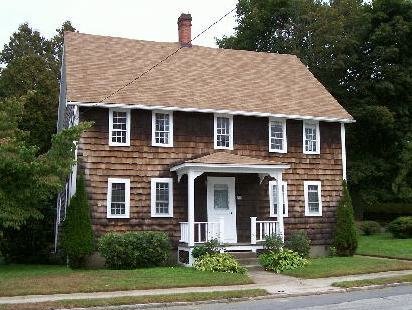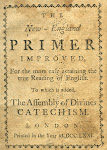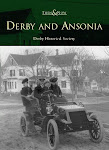This is business as usual, of course, when trying to precisely establish the material history of a very old home. At the time I bought the Hawkins house in 2007, for example, a belief deeply held by local historians was that my house had been moved twice, from one unknown location to another, and then to its current location on Hawkins Street. But my thorough investigation of a number of old maps indicated that the house had always been there. The hard physical evidence then came into play when it finally struck me that the footprint of the present day foundation and stone work surrounding the house lined up exactly with the original, above-grade foundation shown in several old photographs.

The Hawkins house shown in its present day location, on a Hughes and Bailey illustrated map of Derby, c. 1920.
I'm now of the mind that my house had been moved only temporarily, if at all, while the old foundation was being replaced with the current one. Or, perhaps even an in situ jacking and then lowering of the house back in place (undoubtedly a long and creaky affair, that might've even racked the house frame), some how transformed over time into an account of the home being moved between different sites.
More recently, I've begun to seriously question the original date of construction of the house. As my knowledge of the architectural trends of the New Haven Colony continues to expand, I've concluded that the present day Hawkins house is a product of the Third Period of colonization (approx. 1700-1750), and probably even of the later half of that period. In terms of its basic architectural form, the Hawkins house quintessentially is a late Third Period home.

A large joist spanning adjacent tie-beams at one end of the Hawkins house. A First Period home would've had a summer beam in this location (summers were either minimized, or disappeared entirely, around 1750). The half-dove tail joint prevents the tie-beams from drifting apart, so the remaining joists, running parallel to this one, are simply dropped in place, without dove tailed ends. This joist effectively divides the house frame into front and back sections, and supports 2x vertical planks, forming a partition wall just below. You can see the ends of these planks on the left side of the joist.
However, the historical record also tells us that Joseph Hawkins built a home in this location sometime between 1670 and 1681. That home most likely would've been of the First Period style, consisting of two floors, with two rooms on each floor, and a large, central chimney. During the Second and Third Periods, many older, First Period homes were expanded into saltboxes, through the incorporation of a lean-to addition, providing a full kitchen on the first floor in the rear of the house, and small, second floor garrets on either side of the chimney column.

View from the southeast bed chamber looking into the spinning room. Even from a photograph, one can easily discern the downward slope of both the spinning room floor and tie-beam (just over the far door leading into the northeast birthing room).
The present day Hawkins house is not a saltbox; rather, a full two-story home with attic. But recently, I found myself wondering if there were any possibility that my home might be a latter day conversion of an earlier Hawkins house, retrofitted by some descendant of Joseph Hawkins. And with that, of course, some previously unaccounted-for physical evidence began to click in my mind. Two things, in particular, now stand out:
1) The entire rear half of the house frame on the second floor has a distinct downward slope toward the rear wall. In the attic, this is even more apparent: You can clearly see that the front half of the attic floor forms a more-or-less level plane, while the rear half of the attic floor (just beyond the large attic joists that effectively divide the front and rear of the house, while stabilizing adjacent tie-beams) clearly slopes downward. This odd feature often (though not always) is a characteristic of an old timber frame home that had been extended at some point in its past.
2) If my home is indeed a conversion of an older house, it is not at all unlikely (again, based on its architectural style) that that conversion might've taken place in the mid to late 1700s. That might account for the strange "100 yea old" epithet white washed on one of the roof planks in the front of the house. The front half of the house indeed could've been "one hundred years old", at the time when the new, rear addition of the house had just been built. And some one, at the time, might've needed to make a note of that fact.

White washed message on the roof deck, proclaiming "100 yea old". This is in the front section of the Hawkins house attic.
Ultimately, a dendrochronological survey, together with a much more thorough visual inspection of the frame than I've done so far (in search of splices, empty mortises, etc.), should settle these questions. However, until I get at least to that point in my current surveys, any notion of a conversion from an earlier house is but mere speculation on my part.
There also are a number of other oddities through out my home that might eventually find their way to explanations if a Hawkins house conversion could indeed be established, including this strangely filled-in section of the second floor parlor chamber, which spans the entire length of the parlor, and is of the same width as the landing just beyond the door.

Cut-out section of the parlor chamber floor, running along the front wall of the Hawkins house. The cut-out was subsequently filled with shortened planks. I'm curious what I'd find underneath, were I to pry any of the shorts planks up.
I don't know (yet) if there is a corresponding construction in the hall chamber, since its plank flooring is completely covered by a "modern floor" (probably mid-19th century, based on its construction), but at some point, I intend to find out.

Nineteenth century overlay flooring in the hall chamber: 5/4 x 4 tongue-and-groove boards, face-nailed with 8d machine cut square nails.
Here's one final example of physical evidence going unnoticed until some other event makes its meaning more obvious. In the second floor southeast bed chamber, there is a cut-out similar to that of the parlor chamber, only smaller in length. It's also filled by old planks. For some time, I had wondered why it was there. The only obvious thing is that two closet spaces had been built over it in more recent times.

Cut-out in the the second floor southeast bed chamber. The short planks extend out to the far wall of the "closet", which happens to be the vertical plank partition wall described in the first photo of this post.
One day, I was in the cellar, looking up at the first floor rafters for some reason, when I noticed an identical cut-out, filled with modern dimensional lumber, directly under the same location and more or less of the same dimensions. That's when it struck me that this was a remnant of the old rear stairway, which led from the second floor work area in the rear of the house, down to the kitchen, and then further into the cellar. It might've been enclosed in paneling, but one side of it was defined by the old vertical plank partition wall that still divides the front and back of the house to this day (only now covered by plaster and wall board).
Until then, I was always wondering why the Hawkins house never had a second stair in the rear, like other homes of its day. It never occurred to me I'd been looking at it all along.












